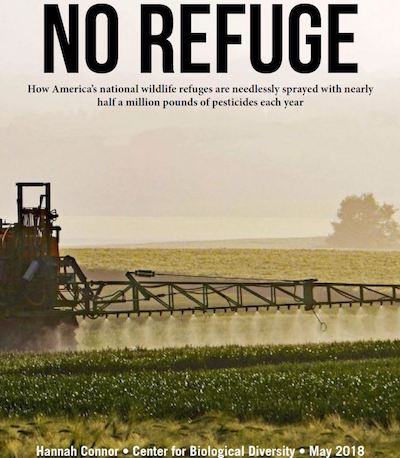Pesticide Use on Crops Grown in Refuges Spikes in California, Oregon, Arkansas, Tennessee, Maryland
WASHINGTON— America’s national wildlife refuges are being doused with hundreds of thousands of pounds of dangerous agricultural pesticides every year, according to a first-of-its-kind analysis by the Center for Biological Diversity. 
The Center report, No Refuge, reveals that an estimated 490,000 pounds of pesticides were dumped on commodity crops like corn, soybeans and sorghum grown in national wildlife refuges in 2016, the most recent year for which data are available. The analysis was conducted with records obtained by the Center under the Freedom of Information Act.
“These refuges are supposed to be a safe haven for wildlife, but they’re becoming a dumping ground for poisonous pesticides,” said Hannah Connor, a senior attorney at the Center who authored the analysis. “Americans assume these public lands are protected and I think most people would be appalled that so many pesticides are being used to serve private, intensive agricultural operations.”
The pesticides include the highly toxic herbicides dicamba and 2,4-D, which threaten the endangered species and migrating birds that wildlife refuges were created to protect. Refuge pesticide use in 2016 was consistent with pesticide applications on refuges over the previous two years, the Center analysis showed.
America’s 562 national wildlife refuges include forests, wetlands and waterways vital to thousands of species, including more than 280 protected under the Endangered Species Act.
Yet intensive commercial farming has become increasingly common on refuge lands, triggering escalating use of highly toxic pesticides that threaten the long-term health of these sensitive habitats and the wildlife that depend on them.
In 2016 more than 270,000 acres of refuge land were sprayed with pesticides for agricultural purposes. The five national wildlife refuge complexes most reliant on pesticides for agricultural purposes in 2016 were:
- Klamath Basin National Wildlife Refuge Complex in California and Oregon, with 236,966 pounds of pesticides;
- Central Arkansas Refuges Complex in Arkansas, with 48,725 pounds of pesticides;
- West Tennessee Refuge Complex in Tennessee, with 22,044 pounds of pesticides;
- Tennessee National Wildlife Refuge Complex in Tennessee, with 16,615 pounds of pesticides;
- Chesapeake Marshlands National Wildlife Refuge Complex on the Eastern Shore of Maryland and Virginia, with 16,442 pounds of pesticides.
Additional findings from the report:
- Aerial pesticide spraying: In 2016, 107,342 acres of refuge lands were aerially sprayed with 127,020 pounds of pesticides for agricultural purposes, including approximately 1,328 pounds of the notoriously drift-prone dicamba, which is extremely toxic to fish, amphibians and crustaceans.
- Glyphosate: In 2016 more than 55,000 agricultural acres in the refuge system were treated with 116,200 pounds of products containing glyphosate, the pesticide that has caused widespread decreases in milkweed plants, helping to trigger an 80 percent decline of the monarch butterfly over the past two decades.
- 2,4-D: In 2016 more than 12,000 refuge acres were treated with 15,819 pounds of pesticide products containing 2,4-D, known to be toxic to mammals, birds, amphibians, crustaceans, reptiles and fish and is likely to jeopardize the continued existence of endangered and threatened salmonids.
- Paraquat dichloride: In 2016 more than 3,000 acres of corn and soybean crops on refuge lands were treated, mainly through aerial spraying, with approximately 6,800 pounds of pesticides containing paraquat dichloride, known to be toxic to crustaceans, mammals, fish, amphibians and mollusks and so lethal it is banned in 32 counties, including the European Union.
“These pesticides are profoundly dangerous for plants and animals and have no place being used on such a staggering scale in our wildlife refuges,” Connor said. “The Interior Department needs to put an end to this outrage and return to its mission of protecting imperiled wildlife, not row crops.”
The Center for Biological Diversity is a national, nonprofit conservation organization with more than 1.6 million members and online activists dedicated to the protection of endangered species and wild places.
